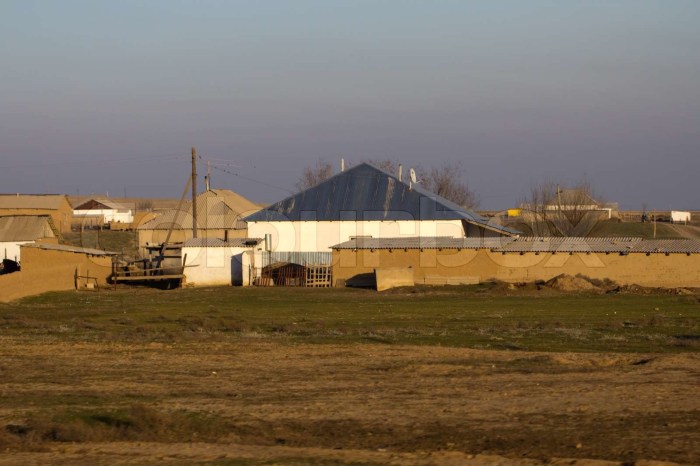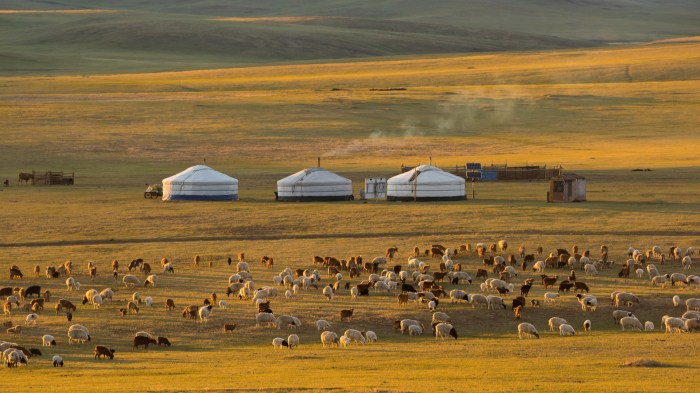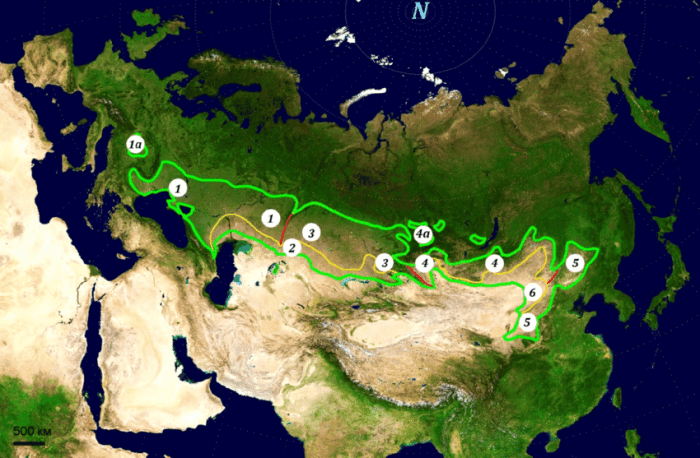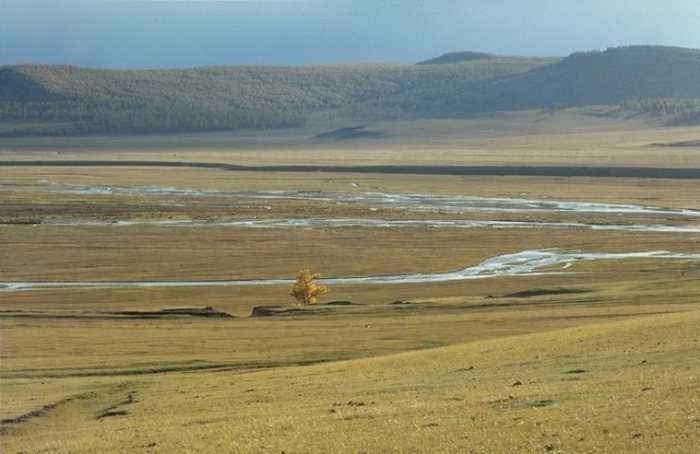Home on the asian steppes – Journey with us to the vast Asian steppes, where history, culture, and nature intertwine in an epic tapestry. From the nomadic lifestyle of its inhabitants to the profound impact it has had on Central Asia, the steppes beckon us to explore a world both ancient and vibrant.
Our odyssey begins with a glimpse into the physical characteristics of this expansive landscape, its climate, vegetation, and topography shaping the lives of those who call it home. We will delve into the unique cultural traditions and practices of the steppe peoples, discovering the significance of music, dance, and storytelling in their vibrant heritage.
Historical Significance

The vast Asian steppes have played a pivotal role in shaping the history and culture of Central Asia. Nomadic tribes have roamed these grasslands for centuries, their way of life intimately tied to the unforgiving landscape.
The steppes served as a crossroads for civilizations, facilitating the exchange of ideas, goods, and technologies. It was here that some of the world’s most powerful empires emerged, including the Mongols and the Huns, who conquered vast territories and left an enduring mark on global history.
The Nomadic Lifestyle
The nomadic lifestyle of the steppe peoples was a response to the harsh environment. They lived in portable tents called yurts, which could be easily disassembled and transported. Their herds of horses, sheep, and goats provided sustenance and transportation.
Nomadic life required adaptability and resilience. The tribes constantly moved in search of pasture and water, following seasonal patterns and avoiding conflict with other groups. This mobility allowed them to survive in a region where resources were scarce and unpredictable.
Significant Historical Events, Home on the asian steppes
The steppes have witnessed numerous significant historical events that shaped the course of Central Asia and beyond.
- The Mongol Empire:Genghis Khan united the nomadic tribes of the steppes and established the largest contiguous empire in history. The Mongols conquered vast territories from China to Eastern Europe, leaving a lasting legacy of cultural exchange and political influence.
- The Silk Road:The Silk Road, a network of trade routes connecting East and West, passed through the steppes. The exchange of goods and ideas along these routes played a crucial role in the development of civilizations in both regions.
- The Russian Conquest:In the 19th century, the Russian Empire expanded into Central Asia, bringing the nomadic tribes under its control. This led to significant changes in the way of life for the steppe peoples and had a lasting impact on the region’s political and economic development.
Home on the Asian steppes is a fascinating topic that offers a glimpse into a unique way of life. For those seeking further exploration, the fiveable ap world unit 3 provides comprehensive coverage of the history and culture of the steppe peoples.
From the nomadic lifestyle to the rise of empires, this unit delves into the complexities of life on the vast Asian steppes, enriching our understanding of this captivating region.
Geography and Environment

The vast Asian steppes stretch across the heart of Asia, encompassing an area of over 10 million square kilometers. This immense landscape is characterized by its extreme climate, sparse vegetation, and flat topography.
Climate
The steppes experience a continental climate, with long, cold winters and short, hot summers. Temperatures can range from -40°C in the winter to 40°C in the summer. Precipitation is scarce, averaging around 250 millimeters per year.
Vegetation
The vegetation of the steppes is dominated by grasses and shrubs. Trees are rare, except in river valleys and other sheltered areas. The grasslands provide grazing for large herds of animals, such as horses, sheep, and goats.
Topography
The topography of the steppes is relatively flat, with rolling hills and occasional mountains. The land is dotted with numerous lakes and rivers, which provide water for both humans and animals.
Influence on Human Life
The harsh environment of the steppes has had a profound influence on the lives of the people living there. The nomadic lifestyle of the steppe peoples has been shaped by the need to find grazing for their animals and to avoid the harsh winters.
The steppes have also been a major crossroads for trade and migration, with people from all over Asia passing through the region.
Cultural Traditions: Home On The Asian Steppes

The vast expanse of the Asian steppes has fostered a unique and vibrant cultural tapestry among its nomadic inhabitants. Their traditions and practices, shaped by centuries of adaptation to the harsh environment, reflect a deep connection to nature, music, and storytelling.
Music and Dance
Music plays an integral role in steppe culture, providing solace, entertainment, and a means of expressing emotions. Traditional instruments include the two-stringed fiddle (morin khuur), the plucked lute (dombra), and the cylindrical drum (chang). Nomadic melodies are often haunting and evocative, reflecting the vastness and solitude of the steppes.
Dance is another important form of artistic expression. The traditional “eagle dance” mimics the graceful movements of the bird of prey, while the “horse dance” showcases the agility and strength of the steppe warriors.
Storytelling
Storytelling holds a revered place in steppe culture, passing down knowledge, history, and values from one generation to the next. Nomadic bards, known as akyn, recite epic poems and folktales that recount the exploits of heroes, the wisdom of ancestors, and the beauty of the land.
Traditional Clothing, Food, and Housing
The traditional clothing of the steppe peoples is designed for both warmth and functionality. Long robes made from animal skins or wool provide protection from the harsh elements. The distinctive headgear, such as the pointed hat (kalpak) and the fur-lined cap (malakhai), reflects their nomadic lifestyle.
The cuisine of the steppes is centered around meat, dairy products, and seasonal vegetables. Mutton, goat, and horse meat are staples, often cooked over open fires. Fermented mare’s milk (kumis) is a popular beverage, while fermented camel milk (shubat) is consumed in some regions.
The housing of the steppe peoples is adapted to their nomadic lifestyle. The traditional yurt, a portable tent made from animal skins or felt, provides shelter and warmth in all seasons. Yurts are easily dismantled and transported, allowing the nomads to move with their herds.
Economic Activities

The people living on the Asian steppes relied on a variety of economic activities to survive in the vast and often harsh environment. These activities included herding, hunting, and trading.
Herding was the most important economic activity for the steppe peoples. They raised animals such as horses, sheep, goats, and cattle. These animals provided them with food, clothing, and transportation. The steppes were well-suited for herding, as they provided abundant grazing land for the animals.
Hunting
Hunting was another important economic activity for the steppe peoples. They hunted a variety of animals, including deer, elk, wolves, and foxes. Hunting provided them with food, clothing, and other materials.
Trading
Trading was also an important economic activity for the steppe peoples. They traded with neighboring peoples, such as the Chinese and the Persians. They traded animals, furs, and other goods for grain, cloth, and other manufactured goods.
Living in a nomadic society presented both challenges and opportunities. One of the challenges was the need to constantly move in search of food and water. This could be difficult, especially during the winter months. However, nomadic societies also had the opportunity to adapt to changing environmental conditions.
They could move to areas with better grazing land or hunting grounds as needed.
The steppe peoples developed a variety of traditional crafts and industries. These included leatherworking, metalworking, and weaving. They also produced a variety of goods, such as felt tents, saddles, and weapons.
Modern Transformations
The steppes have undergone significant transformations in recent decades. Urbanization, industrialization, and globalization have left an indelible mark on this once-nomadic landscape.
Industrialization has brought new economic opportunities to the steppes, but it has also led to environmental challenges. Globalization has connected the steppes to the wider world, but it has also exposed them to new cultural influences.
Challenges
- Environmental degradation, including desertification, soil erosion, and water pollution.
- Loss of traditional livelihoods, such as herding and agriculture.
- Social problems, such as poverty, unemployment, and crime.
- Cultural erosion, as traditional values and practices are replaced by modern ones.
Opportunities
- New economic opportunities, such as mining, manufacturing, and tourism.
- Improved access to education and healthcare.
- Increased cultural exchange and understanding.
- Preservation of traditional cultures through cultural heritage programs and initiatives.
Preservation Efforts
Efforts are being made to preserve the cultural heritage of the steppe peoples. These efforts include:
- Documenting traditional languages, music, and dance.
- Establishing cultural centers and museums.
- Supporting traditional crafts and livelihoods.
- Promoting cultural tourism.
FAQ Compilation
What is the significance of the Asian steppes?
The Asian steppes have played a pivotal role in shaping the history and culture of Central Asia, serving as a crossroads for nomadic tribes and a stage for significant historical events.
How has the harsh environment of the steppes influenced its inhabitants?
The harsh climate and rugged terrain of the steppes have fostered a resilient and adaptable people, whose nomadic lifestyle and cultural practices have been shaped by the challenges of their environment.
What are some of the unique cultural traditions of the steppe peoples?
The steppe peoples possess a rich cultural heritage, including traditional music, dance, storytelling, clothing, food, and housing, all of which reflect their nomadic lifestyle and deep connection to their environment.